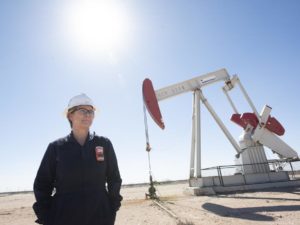 For a transition to a renewable energy infrastructure to occur, we have to develop commercial-scale clean technology. Many energy experts agree that such a transition will require the assistance of the oil and gas sector, and when it comes to funding clean energy development, one Houston-based oil giant is putting its money where its mouth is.
For a transition to a renewable energy infrastructure to occur, we have to develop commercial-scale clean technology. Many energy experts agree that such a transition will require the assistance of the oil and gas sector, and when it comes to funding clean energy development, one Houston-based oil giant is putting its money where its mouth is.
A joint venture subsidiary under Houston-based Occidental Petroleum Corp. (NYSE: OXY) is developing what will be the largest direct air capture facility in the world once completed. The joint venture, called 1PointFive Inc., plans to construct a direct air capture facility capable of extracting up to 1 million metric tons of atmospheric carbon dioxide annually.
The plant will capture CO2 and process it into an industrial gas for use by Oxy and other upstream oil and gas firms in enhanced oil recovery. The product is sequestered in the geological formations underground to keep it out of the atmosphere.
Occidental subsidiary Oxy Low Carbon Ventures and private equity firm Rushdeen Capital make up the joint venture developing the world’s first commercial-scale direct air capture project. Richard Jackson, president of operations for U.S. onshore resources and carbon management for Oxy, said much of this year will be devoted to the front-end engineering and design of the 1PointFive facility. The joint venture plans to close financing and begin construction in 2022.
“There are different technologies which fit different sizes and scale, but I think this will be significantly larger than any that have been put together so far,” Jackson said.
1PointFive plans to build the massive direct air capture (DAC) plant in the heart of Texas oil and gas country — the Permian Basin. Tax incentive applications filed with the state show that 1PointFive is considering building the DAC plant in Ector County, which contains Odessa, Texas.
The development of the DAC project is expected to require 1,000 workers at its peak, according to tax incentive applications. Jackson said the workforce needed to develop such critical infrastructure is significant. Earlier this year, 1PointFive selected Australian engineering firm Worley to handle the front-end engineering and design work for the plant. Many more partners will be needed to complete development, Jackson said.
“While it’s on us as a company like Oxy to prove and de-risk the business model, we think once we do that, there will be many beneficiaries — from the climate to the labor to the value chain and the workers that it can create,” Jackson said.
One necessary step before construction can go forward is securing financing. The development of such a large DAC plant will cost hundreds of millions of dollars — possibly billions of dollars as you look out over decades, Jackson said. The joint venture will need capital to help support the build out. Chicago-based United Airlines (Nasdaq: UAL) announced late last year that it would make a multimillion-dollar investment in 1PointFive.
This probably won’t be the only time Oxy considers building a DAC plant in the Permian Basin. Being able to put these plants next to existing pipeline and reservoir infrastructure is critical that the CO2 can be permanently sequestered, Jackson said. For that reason, the Permian region in West Texas and New Mexico present attractive opportunities for additional projects.
“The opportunity is obviously to build more in the Permian for scale for our current CO2 injection and storage,” Jackson said. “We store about 18 million tons per year, so this would be 1/18th of our total injection and storage.”
Oxy is involved with several other innovative projects tackling the problem of carbon emissions. Oxy Low Carbon Ventures is capturing emissions from two White Energy ethanol plants in the Texas Panhandle for injection and sequestration in order to make carbon-neutral oil. In March, Oxy and Houston-based liquefied natural gas company NextDecade agreed to build a carbon pipeline and storage facility near NextDecade’s proposed LNG terminal in Brownsville, Texas. Oxy would transport the CO2 captured at the NextDecade terminal for sequestration.
Earlier in April, Oxy Low Carbon Ventures and Houston-based bioengineering startup Cemvita Factory announced plans to construct a bio-ethylene pilot plant that would apply human-made CO2 instead of hydrocarbon-sourced feedstocks. The pilot project will serve as a starting point to scale the technology, jointly developed by Cemvita and Oxy Low Carbon Ventures, which showed to be competitive with hydrocarbon-sourced ethylene processes in lab tests.

